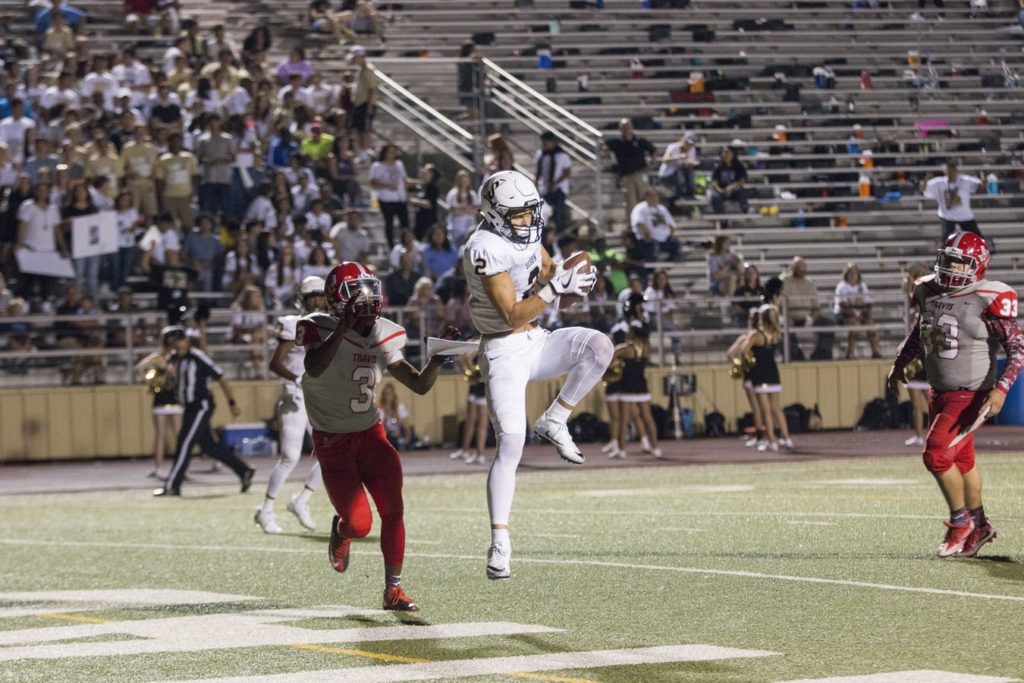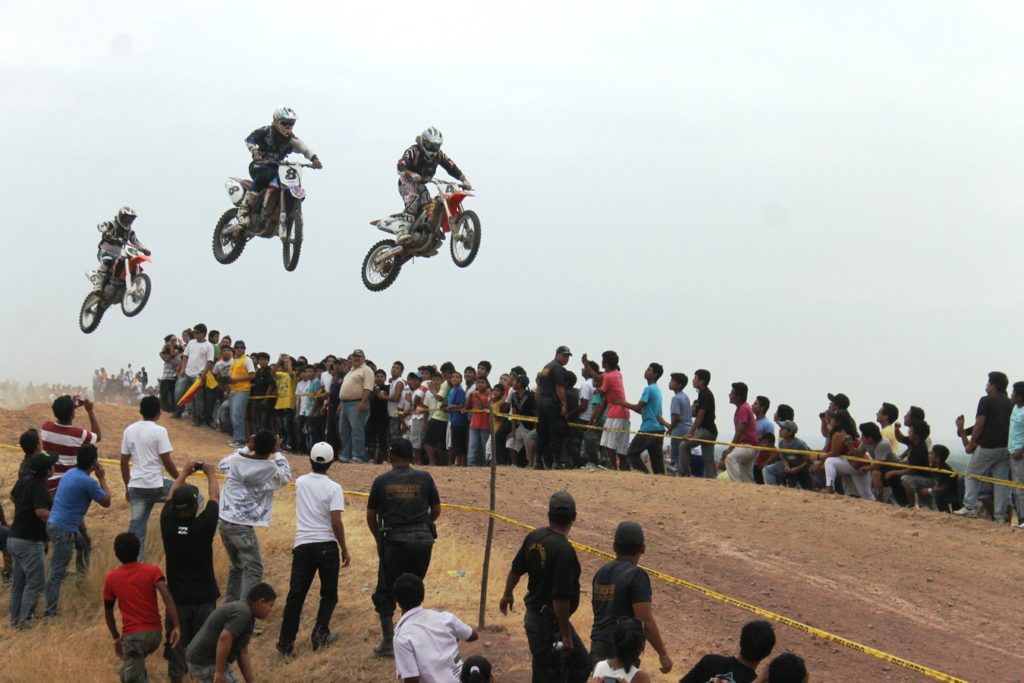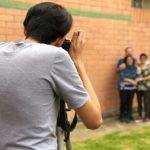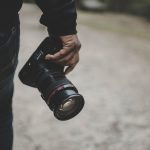It’s third down and long yards for the underdog team under the Friday night lights. Barely 20 seconds on the clock. You can feel the electricity pulsing over the field, bouncing off the crowd of fans who know this is the moment that precedes the sweetness of victory or the agony of defeat.
A skilled sports photographer is already one step ahead of the crowd. It’s almost a certain bet the quarterback is going to fade back, feint and throw a long pass downfield. Action photographers learn to anticipate what’s coming. That’s why they’re able to capture those spectacular photos of a wide receiver leaping through the air to catch the ball in one hand and land in the end zone. Touchdown. Buzzer. Game over.

The thrill of action. The joy of competition. These sensations are part of the life of an action/sports photographer. Freezing those heroic moments in time is a big part of the job. So is capturing the reaction of the losing team on the opposite sideline.
Action photographers tell stories with their images. They tell the story of the game. They travel to the action, wherever and whatever it may be – from motocross bikes flying through the air to snowboarders demonstrating their death-defying skill at sliding down a mountain like they were born to do nothing else.
If you love the thrill of the game, the adrenaline rush of action and want to see events in person, not only for free, but get paid well to be there, a career as an action/sports photographer may be what you seek. Read on to learn what’s involved in getting started. When the action begins, you’ll be ready to document what went down for the sake of history.
In this article you’ll learn:
- How much money you can make as an action/sports photographer
- The required training and certifications
- Professional groups to join
- Employment opportunities for action/sports photographers
- Finding clients
- Plus helpful tips
How much money can you make?
Action/sports photographers average $30,367 per year, according to a recent GlassDoor survey. Freelancers can potentially earn much more, especially if they are shooting major events such as college or professional football and basketball games, regional and international athletic competitions, including the summer and winter Olympics, and any action event that attracts a large audience and fan base.
Training and Certification
You don’t need any certification to be an action or sports photographer. No license is required. But to score gigs as a credible professional, you must be able to shoot expertly with a camera – and have a portfolio of excellent images as proof.

Many classes are available both online and in-person for you to learn action photography. Some courses include a certification of completion for you to frame and display in your office and mention on your business website. Some photographers have a bachelor’s degree in fine arts with a focus on photography. Any credential or degree that helps promote you as a professional action photographer should definitely be used. These achievements will set you apart from competitors while showing that you are serious about your work.
A simple Internet search will turn up a wealth of action photography courses for you to review. Some cost less than $50. More advanced and more expensive courses may include feedback from an instructor, typically a professional in the field. If you’re more interested in attending a class in person, check the offerings at community colleges and nearby universities that offer continuing education.
Visit your local camera shops as well. Often, pro photographers will offer their own classes as a sideline to their photography business. They tend to advertise where photographers congregate – at camera shops and online discussion groups devoted to action photography.
Here’s an example of a course offering in sports photography where students choose a training package from 1 to 10 games. This hands-on learning involves photographing actual sporting events.
A few thoughts on equipment:
There are dozens of books, websites and photography magazines available to help you decide which gear to buy. Your needs may be different from another photographer’s, so only you can decide which brand or model of camera suits your requirements.

At minimum, though, you’ll need a DSLR (digital single lens reflex) camera body and at least two lenses, wide and telephoto. Two camera bodies are even better because then you won’t be spending so much of your time switching out lenses while the action passes you by.
A set of neutral density and polarizing filters will help you manage lighting conditions. Spare camera batteries and memory cards are critical. And you’ll need a water-resistant bag to carry your equipment.
Tripods are a rare sight these days at sporting events unless they’re holding up heavy television cameras. To stay mobile, most action photographers will use a monopod if they need camera support and stabilization, usually when capturing telephoto shots where camera shake is much more noticeable with a long lens.
Finally, a computer or laptop loaded with image editing software such as Photoshop will be needed to work on your photographs in post-production. As your photography business grows, digital storage will become an issue. There are many online storage solutions (cloud storage), some of them even free for a certain volume of storage. Google Drive is one example. As a backup measure, though, you may want to invest in external hard drives that can store many thousands of high-definition images. These drives connect directly with a cable to your laptop or computer for immediate access. One advantage of an external drive is you do not need an Internet connection to access your work. Another is that your work product is always under your control.
Professional Groups to Join
There are many professional photographers’ organizations you can join to network with other pros and advance your action/sports photography career. Here are some of the most relevant to action photographers:

If you’re covering organized sporting events, consider joining the National Press Photographers Association. While they are dedicated to the support of news photojournalists, that doesn’t exclude professional photographers who cover major events such as college and pro sports, or even athletic competitions at the high school level, as these are closely followed by many people in a community. This association offers professional memberships to photojournalists for $145 per year. The association advocates for the profession, monitors and reports on international conditions for photojournalists and offers networking opportunities for members.
Professional Photographers of America is the premiere organization of photography pros in the United States. A full membership is open to anyone living in the United States or its territories and costs $323 per year. Benefits include:
- $15,000 equipment insurance policy
- Data loss protection
- Access to all online education courses
- Online referral database listing
- Printed and digital monthly issues of Professional Photographer magazine
- One full registration to Imaging USA during the first year of membership
- Business Resources
- Contracts and Copyright Resources
- Access to Member Discount Program
- Weekly newsletter
Benefits include a photographer photo ID card, discounts on Apple electronics, a listing in the association’s directory to help new clients find you, and more. Membership tiers range from $50 to $500 per year.
Employment
Contact newspapers, magazines and the editors of online sites devoted to sports and action photography. Send them your marketing materials, brochures and business cards. Follow up with a phone call in a day or two. If your contact says he’s already working with a photographer, ask if he knows anyone who needs your services. Don’t be discouraged by rejection when calling potential clients. The very next call you make could be gold.

Use the networking power of your professional memberships to find assignments.
Develop and maintain working relationships with publications in your area. Be flexible in your schedule. If the local newspaper’s sports photographer is suddenly unable to shoot the Saturday afternoon game, you might get a call asking if you can fill in on the assignment.
Finding Clients
Business cards and a basic website should be the core of your marketing toolkit as an action/sports photographer. The website need not be fancy or expensive, just attractively designed, with photos of your best work, your business location and contact information. No need to include your pricing. You can discuss that directly with clients.

In addition to your business website, the next thing to do is create an Instagram account to showcase your photography. Instagram is the #1 online venue for creative professionals to display their work. It’s a free promotional tool that’s always working on your behalf.
Good to know
Here are essential tips from professional sports photographers who’ve spent years honing their skills.
Do your research.
Always be thumbing through sports magazines, websites devoted to action photography, and regional and local newspapers. Study the styles of images they publish. If you want to shoot for Sports Illustrated you need a current understanding of what they use.
ABA: Always Be Anticipating.
Whether a skydiving event or a basketball game, action involves movement from point A to point B. If you can anticipate where the action is headed, you are better prepared to get the shot. Developing this skill also means you’ve got time to make adjustments on your camera settings before you have to press the shutter button.
Watch for the reaction.
Capturing the touchdown photo is obviously important. Seconds later, a fan’s reaction up in the bleachers may also produce a glorious image.
Carry two cameras.
This way, you’re always ready to shoot tight with a telephoto or loose with a wider lens. If you are constantly changing out the lens on a single camera body you are liable to miss more shots than you capture.

Compose with clean backgrounds.
The focus should be on the action at hand, not background clutter. One way to control background “noise” is by shooting at the lowest possible f-stop (aperture) so your backgrounds appear soft and diffuse.
Look for fresh angles.
Whenever possible, get to an event early so you can scout good shooting locations. People see at eye level, so if all you shoot is eye-level images then you’re not creating a new or unique style for your work.
Get a liability insurance policy.
And keep it up to date. You may also want to have an attorney set up your operation as an LLC (Limited Liability Company). This affords you many legal protections in the event of disputes.
If you enjoyed this article, check out some more great PocketSuite.io content that can help you grow your career as an action/sports photographer. Here’s a great place to start.PocketSuite has thousands of business owners who all started where you are right now. Our community is always happy to help you ramp up, grow your client base, and achieve your income goals, both within the PocketSuite app and as part of our exclusive Facebook Community Group. PocketSuite’s vision is for any professional to be able to work for themselves and make a great living. It starts here. It starts with you. It starts today. Let’s get started, download PocketSuite now! Feel free to reach out with any questions (we’d love to hear from you)! Text us @ (415) 841-2300.



